Available Soil Micronutrient Status as Influenced by Tillage Practices, Nutrient Levels and Foliar Application After Redgram (Cajanus Cajan L.)
0 Views
GURRALA SURESH*, A.V. NAGAVANI, V. SUMATHI, T. GIRIDHARA KRISHNA, P.SUDHAKAR AND G. KARUNA SAGAR
Department of Agronomy, S.V. Agricultural College, ANGRAU, Tirupati
ABSTRACT
A field experiment was conducted during two consecutive kharif seasons of 2019-20 and 2020-21 to study the influence of tillage, nutrient levels and foliar sprays on post-harvest soil available micro nutrient status of redgram on sandy loam soil which was low in available nitrogen, medium in available phosphorus and available potassium. The experiment was conducted in a split – split plot design, consisting of three tillage practices as main plots, three nutrient levels in sub plots and three foliar sprays in sub- sub plots. Tillage, nutrient and foliar sprays could not exerted significant influence on post-harvest soil available micronutrient status. But higher soil available micronutrient content was recorded with vertical tillage with subsoiler upto 60 cm deep at 1 m interval with application of 125% RDF and foliar application of KNO3 @ 1% twice with 15 days interval from 50 per cent flowering stage.
KEYWORDS: Foliar sprays, Micronutrients, Nutrient levels, Redgram and Tillage
INTRODUCTION
Pulses play an important role in Indian agriculture and source of protein for the poor as well as for the vegetarians which constitute major population of the country. Pulses mainly include chickpea, pigeonpea, lentil, mungbean, urdbean and fieldpea. The split grains of pulses called dal are excellent source of high quality protein, essential amino and fatty acids, fibers, minerals, vitamins and help to check obesity, diabetes besides fixing atmospheric nitrogen up to 200 kg ha-1 (Anonymous, 2010). Redgram (Cajanus cajan L.) is one of the important pulse crops of India and ranks second after chickpea in area and production. In India redgram was grown over an area of 4.45 million hectares with production of 3.83 million tonnes and 937 kg ha-1 productivity (Anonymous, 2020). In Andhra Pradesh, redgram is grown under rainfed conditions to an extent of 2.43 lakh hectares with an annual production of 1.19 lakh tonnes and productivity of 486 kg ha-1 (Anonymous, 2020).
Tillage, nutrient management is also described as the technique of using optimum effective dose of sufficient and balanced fertilizers in combination with foliar sprays to make nutrients more available and most effective for maintaining higher yields without exposing soil native nutrients and polluting the environment. Furthermore, many benefits can also be gained from using integrated tillage and nutrient management practices which also act a driving force to support the plans for improving post- harvest soil fertility. Vertical tillage with subsoiler, which loosens the subsoil without inverting and aimed at stimulating greater and faster penetration of roots and helps in increasing the availability of nutrients and moisture to the plants. (Reeves and Mullins, 1995; Tursic et al., 1998). Nutrient management practices may improve micronutrients viz., copper, manganese, iron and zinc availability in soil due to higher nutrient doses which enhances mineralization and availability of nutrients as well as they increase root nodules formation on roots and soil microbial activity. Usually, the farmer’s fertilizer programs focus solely on soil applied NPK, without plans for foliar application. This is necessary to find the appropriate land configuration and techno-economic nutrient management package for redgram production under prevailing conditions. Hence, keeping all these points in view, the present investigation is planned entitled with effect of different tillage, nutrient management practices and foliar sprays on post-harvest soil available micro nutrient status after redgram.
MATERIAL AND METHODS
A field experiment was conducted by Department of Agronomy at S.V. Agricultural College, Tirupati,
Acharya N.G. Ranga Agricultural University, Andhra Pradesh during two consecutive kharif seasons of 2019- 20 and 2020-21 to study the post-harvest soil available micronutrient status as influenced by tillage practices, nutrient levels and foliar application of KNO3 and borax after redgram. The soil of the experimental field was sandy clay loam in texture, low in available N, medium in available P, and available K (Table 1). Pigeonpea variety LRG-52 was used for experimentation. The experiment was laid out in split-split design with three tillage practices (T1 : Conventional tillage with tractor drawn cultivator, T2 : Ploughing with duck foot cultivator upto a depth of 30 cm and T3 : Vertical Tillage with subsoiler upto 60 cm deep at 1.0 m interval) in main plots, three nutrient levels viz., N1 : 75% RDF, N2 : 100% RDF (20 : 50 : 00 kg ha-1) and N3 : 125% RDF in subplots and three foliar sprays (F1 : Control – No spray, F2 : Borax – 0.1% F3 : KNO3 @ 1%) in sub-sub plots.
The initial representative soil samples were taken at a depth of 0-20, 20-40 and 40-60 cm from each plot following the existing procedure. The sample was air dried, powdered, sieved through 2 mm sieve and used for analysis of micronutrients viz., zinc, copper, iron and manganese. After harvesting, soil samples were collected from the root zone depth at 0-20, 20-40, and 40-60 cm from each plot and composite samples were prepared for chemical analysis. Twenty grams of soil was shaken with 40 ml of DTPA extract of pH 7.3 for 2 hours, the contents were filtered and in the filtrate iron, manganese, zinc and copper were determined by using atomic absorption spectrophotometer (Varian A A 240 FS) (Lindsey and Norvell, 1978) and expressed in mg kg-1.
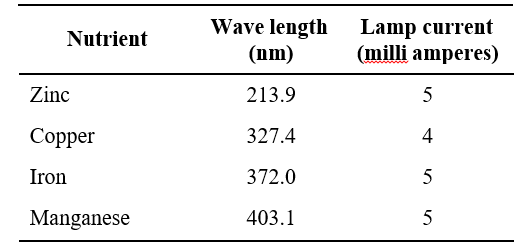
RESULTS AND DISCUSSION
Post-harvest soil available micronutrients
During both the years of experimentation and in pooled mean, the post-harvest soil available micronutrient status of copper, manganese, iron and zinc at different depths was not significantly influenced by tillage, nutrient management practices and foliar sprays as well as their interaction during both the years of investigation inclusive of pooled mean.
Post-harvest soil available micronutrients at 0-20 cm depth
The soil available micronutrients viz., copper, manganese, iron and zinc content were recorded higher
Table 1. Initial available micronutrient status after redgram
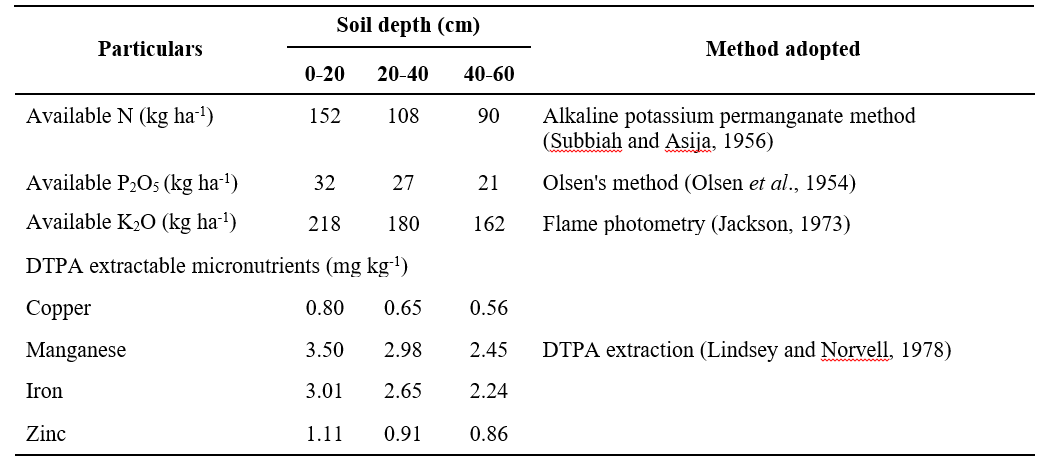
Table 2. Post-harvest soil available micronutrient content (mg kg-1) at 0-20 cm depth as influenced by tillage, nutrient levelsand foliar application afterredgram
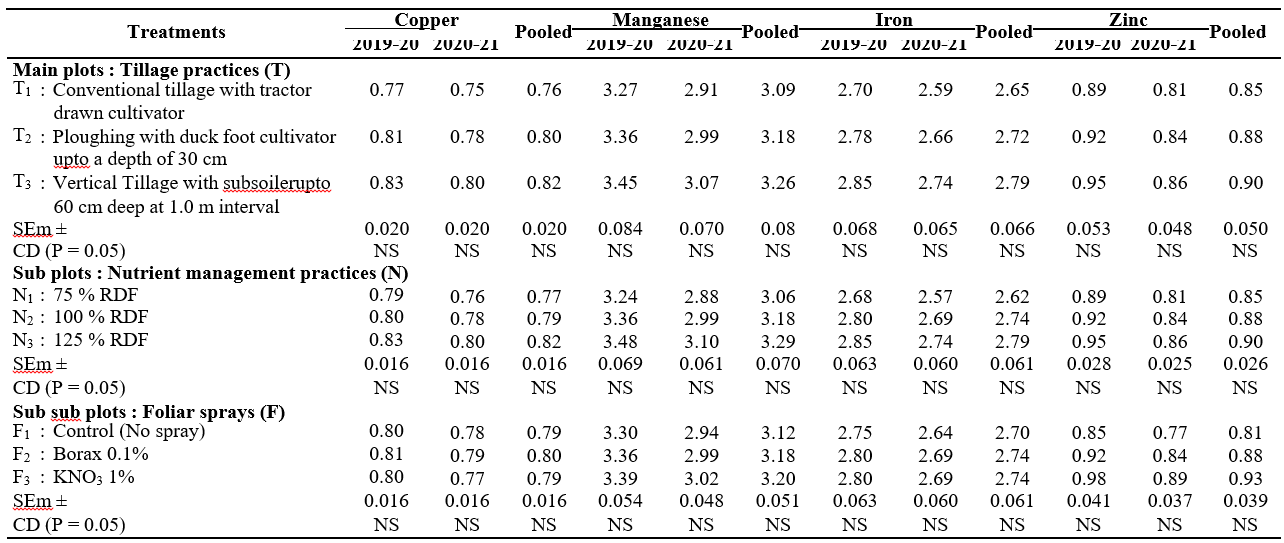

Table 3. Post-harvest soil available micronutrient content (mg kg-1) at 20-40 cm depth as influenced by tillage ,nutrient levels and foliar application after redgram
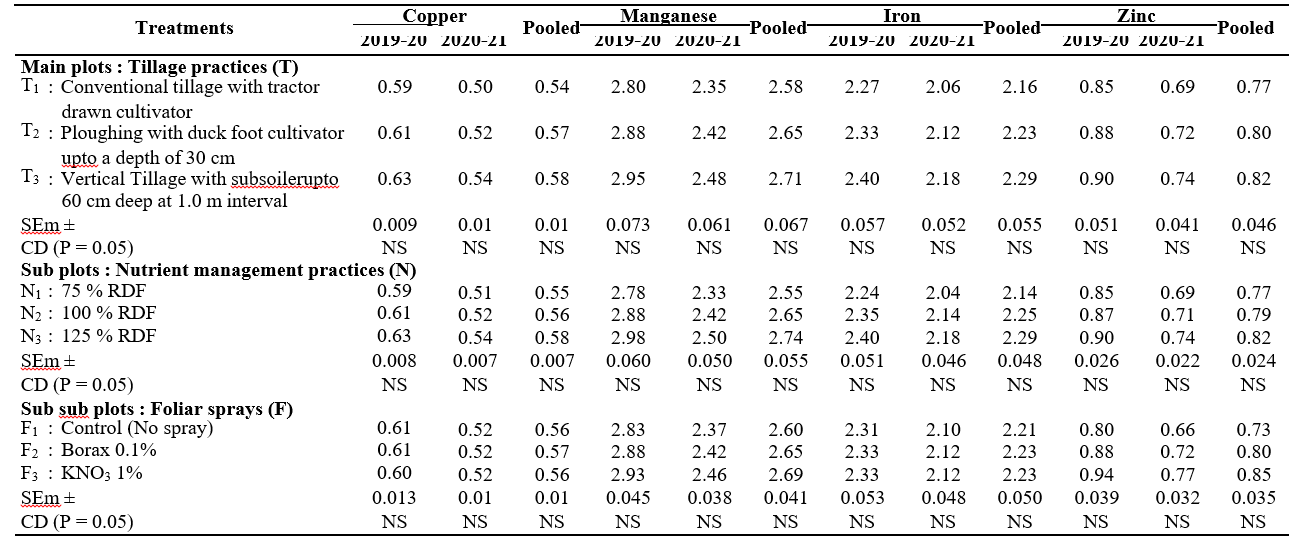

Table 4. Post-harvest soil available micronutrient content (mg kg-1) at 40-60 cm depth as influenced by tillage ,nutrient levels and foliar application after redgram
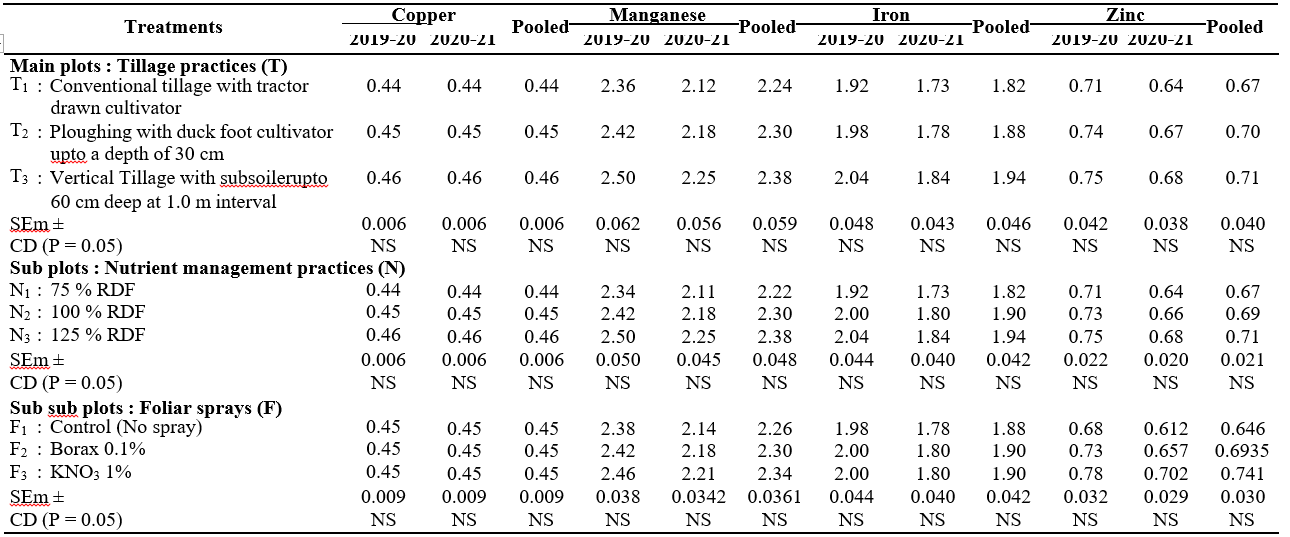

with vertical tillage with subsoiler upto 60 cm deep at 1 m interval (T3) followed by ploughing with duck foot cultivator upto a depth of 30 cm (T2) and conventional tillage with tractor drawn cultivator (T1) with no significant disparity among tillage treatments during both the years of experimentation as well as in pooled mean. The soil available micronutrients were maximum with application of 125% RDF (N3), followed by 100% RDF (N2) and 75% RDF (N1) with no significant disparity among the treatments during both the instances of study and in pooled mean. Foliar sprays failed to exert significant influence on soil available micronutrients during the two years of investigation (Table 2).
The interaction of tillage, nutrient management practices and foliar sprays was found to be non-significant in affecting post-harvest nutrient availability of copper, manganese, iron and zinc during both the years of study.
Post-harvest soil available micronutrients at 20-40 cm depth
Tillage, nutrient management practices and foliar sprays as well as their interaction could not exert significant influence on post-harvest soil available micronutrient status during both the years of study inclusive of pooled mean (Table 3).
Available micronutrients viz., copper, manganese, iron and zinc content were maximum with vertical tillage with subsoiler upto 60 cm depth at 1 m interval (T3) followed by ploughing with duck foot cultivator upto a depth of 30 cm (T2) and conventional tillage with tractor drawn cultivator (T1) with no significant disparity among the treatments during both the years of study and in pooled mean. Among the nutrient levels, higher micronutrient contents viz., of copper, manganese, iron and zinc were observed with 125% RDF (N3) followed by 100% RDF (N2) and 75% RDF (N1) and found at par during the two years of investigation. The effect of foliar treatments on available micronutrient status was found to be non- significant during both the years of study and in pooled mean.
Post-harvest soil available micronutrients at 40-60 cm depth
Post-harvest soil available micronutrients did not differed with tillage, nutrient management practices and foliar sprays as well as their interaction during both the years of investigation and in pooled mean. Higher values
of soil available micronutrient viz., copper, manganese, iron and zinc content were recorded with vertical tillage with subsoiler upto 60 cm deep at 1 m interval (T3) followed by ploughing with duck foot cultivator upto a depth of 30 cm (T2) and conventional tillage with tractor drawn cultivator (T1) with no significant disparity between any two tillage treatments during both the years of experiment.
The available micronutrient status was maximum with application of 125% RDF (N3), followed by 100% RDF (N2) and 75% RDF (N1) with no significant disparity among the treatments during both the years of study. Among the tillage practices studied, maximum availability of micronutrients in soil after harvest of redgram was recorded (Table 4) with vertical tillage with subsoiler upto 60 cm depth at 1 m interval (T3) during both the years of experiment. This might be due to higher root activity and favourable soil moisture conditions that increased the mineralisation of nutrients and helped to increase the availability of nutrients. Application of 125% RDF (N3) recorded higher micronutrient availability at different depths might be due to more amount of nitrogen, phosphorus and potassium applied to soil which enhances micronutrient content in soil after harvesting of redgram. Foliar sprays failed to exert significant influence on available micronutrient content during the two years of investigation. But higher soil available micronutrients content was registered with foliar application of KNO3 1% (F3) might be attributed to the increased nodule count which was responsible for increased nitrogen fixation as well as micronutrient mineralization and transformed to available form (Nanasaheb, 2012).
It was evident that postharvest soil available micronutrient status was not significantly influenced by different tillage, nutrient levels and foliar sprays after redgram in sandy clay loam soils of Tirupati.
LITERATURE CITED
Anonymous. 2010. Annual report of AICRP on Redgram, Indian Institute of Pulses Research, Kanpur 2010.
Jackson, M.C. 1973. Soil Chemical Analysis. Prentice Hall of India. Private limited, New Delhi, 498.
Lindsey, W.L and Norvell, W.A. 1978. Development of DTPA soil test for zinc, iron, manganese and copper. Soil Science Society of America Journal. 42: 421- 428.
Nanasaheb, R.M. 2012. Effect of foliar application of calcium nitrate and potassium nitrate on growth, yield and quality of chickpea. M.Sc. (Ag.) Thesis. Mahatma Phule Krishi Vidyapeeth, Rahuri, India.
Olsen, S.R., Cole, C.V., Watanabe, F.S and Dean, L.A. 1954. Estimation of available phosphorus in soil by extraction with sodium bicarbonate. United States Department of Agriculture. Circular number: 939.
Reeves, D.W and Mullins, G.L. 1995. Subsoiling and potassium placement effects on water relations and yield of cotton. Agronomy Journal. 87:847-852.
Subbiah, B.V and Asija, G.L. 1956. Rapid procedure for estimation of available nitrogen in soils. Current Science. 25: 259-260.
Tursic, I., Mesic, M., Kosutic, S and Filipovic, D. 1998. Application of chisel plough in tobacco production in agroecological conditions in Podravina. Proc. 26th International Symposium on Agricultural Engineering, Opatija, Croatia. 3-6 : 253-260.
- Morphological Characterization of Sesame (Sesamum Indicum L.) Genotypes
- Effect of Liquid Biofertilizers on Productivity of Sesame (Sesamum Indicum L.)
- Profile Characteristics of Stakeholders in the Banana Value Chain: A Gender Analysis
- Studies on Genetic Variability and Genetic Parameters for Grain Yield and Its Components in Foxtail Millet (Setaria Italica (L.) P. Beauv.)
- Morphological Basis for Resistance Against Whitefly in Castor
- Dus Testing of Sesame (Sesamum Indicum L.) Accessions Using Morphological Descriptors

